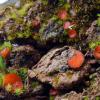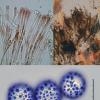
13-06-2017 16:41
 Pérez del Amo Carlos Manuel
Pérez del Amo Carlos Manuel
Un salugo a todos: No consigo encajar bien con l

13-06-2017 06:44
Ethan CrensonI collected these fruiting bodies in the Bronx, NY

05-06-2017 13:27
 Andgelo Mombert
Andgelo Mombert
Bonjour à tous,Sur tige morte de Lonicera xyloste

12-06-2017 20:31
en caña de humbelifera A ver si hay alguna suger

11-06-2017 18:43
Hi to everyoneI need the next article on Lasionect
Scutellinia
Pérez del Amo Carlos Manuel,
13-06-2017 16:41

Un salugo a todos:
No consigo encajar bien con las claves esta Scutellinia.
Ascomas pequeños de 4-8 mm de diámetro. En zona húmeda, directamente sobre la tierra.
Ascas 210-260 x 15-30 micras
Paráfisis: 8-12 micras de anchura
Esporas con verrugas gruesas de 18-200 x 16-20 micras. Q=1,08. Verrugas de 1-2,5 micras
Pelos cortos, con base simple, en ocasiones bifurcada de 150-300 micras.
Gracias.
Carlos M. Pérez



